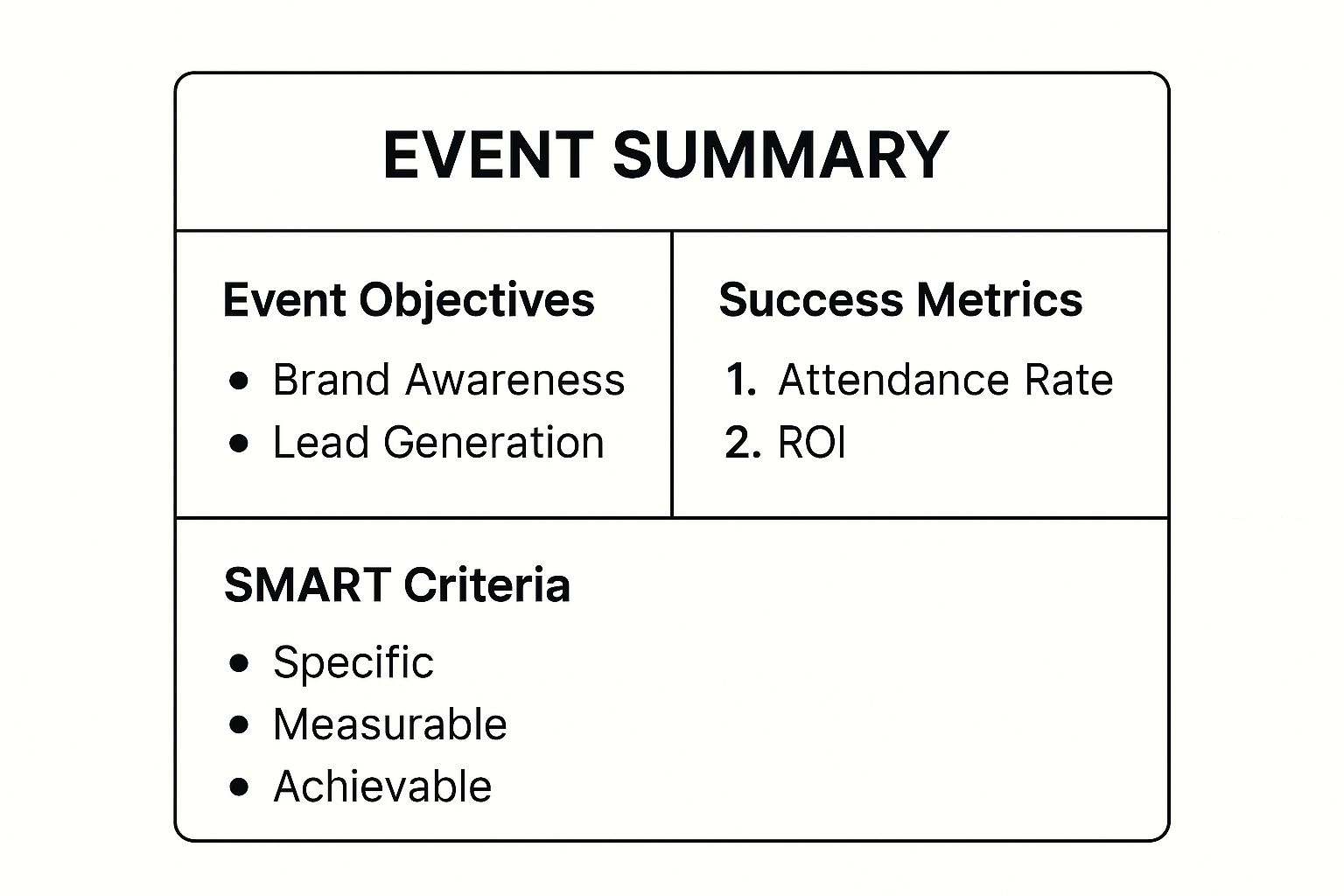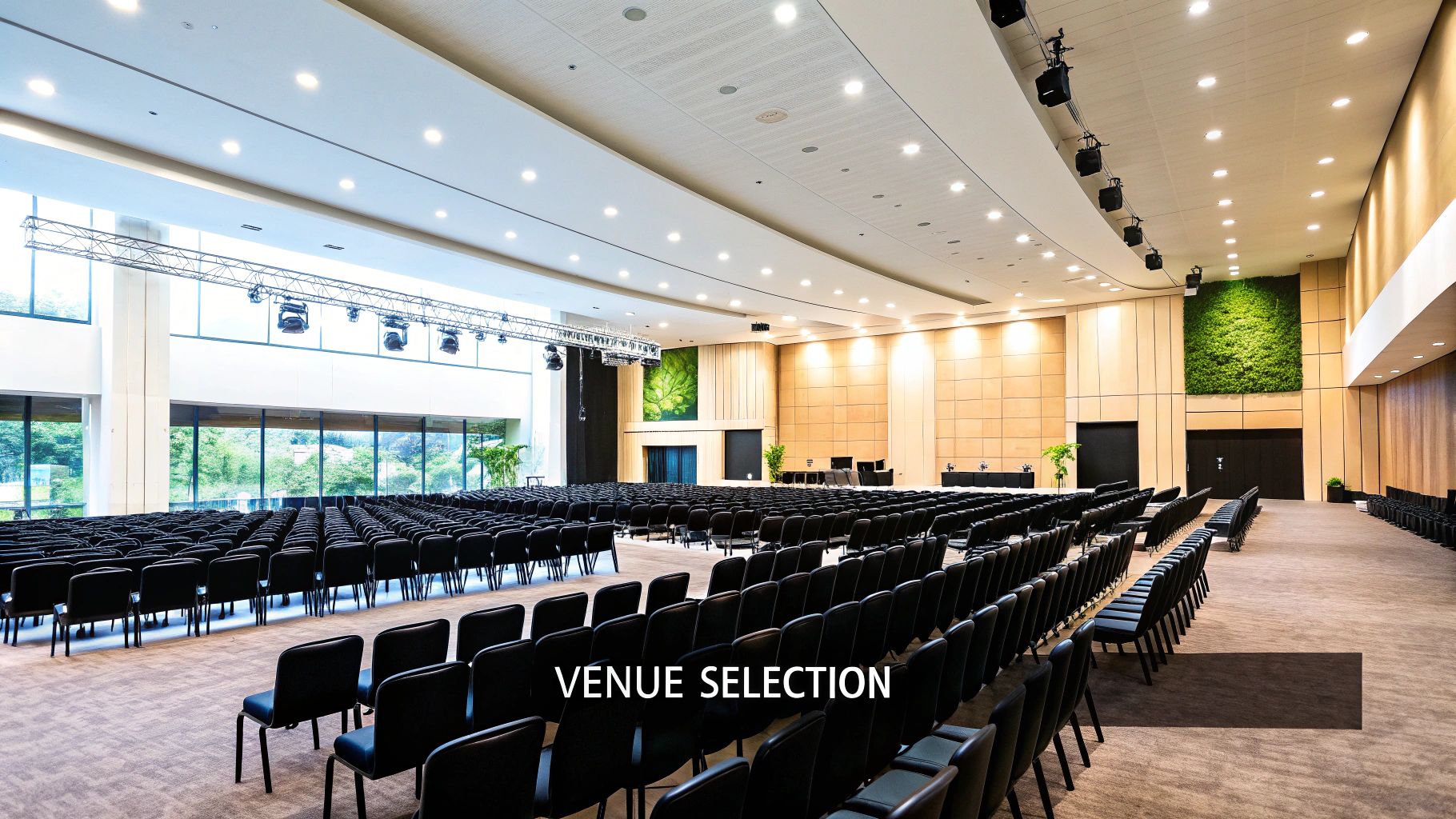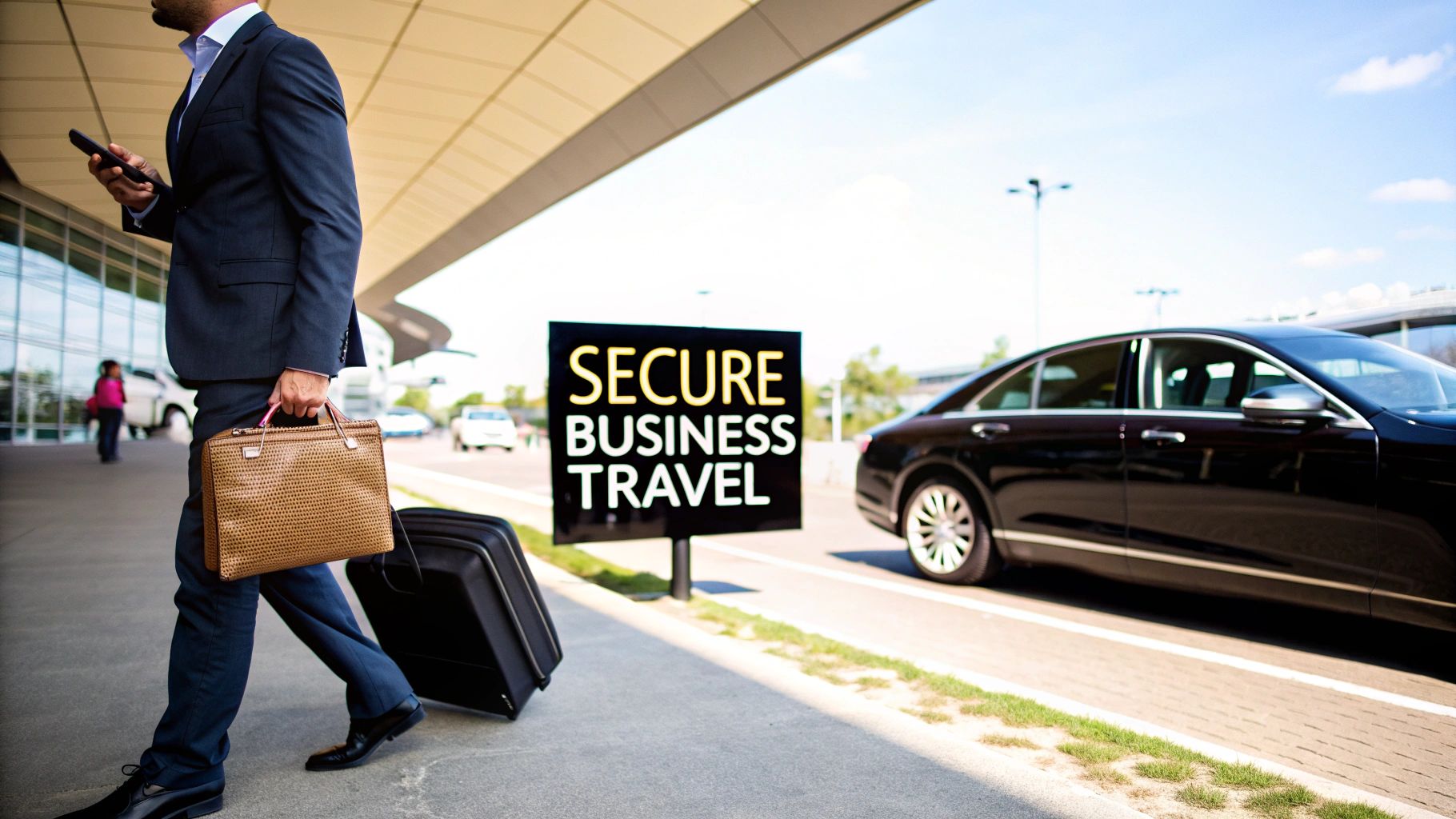Corporate events are no longer just dates on a calendar; they are powerful strategic tools that can define a brand, foster collaboration, and drive business growth. Executing a flawless event, however, requires more than just booking a venue and sending invitations. It demands meticulous planning, strategic foresight, and an unwavering focus on the attendee experience. From a local San Diego product launch to a global sales conference, the principles of exceptional event management remain constant.
This guide provides actionable corporate event planning tips, breaking down the complex process into manageable, high-impact strategies. We will move beyond generic advice to deliver a comprehensive blueprint for success. You will learn how to set measurable objectives, manage complex budgets with built-in contingencies, and select the perfect venue. We will also explore how to develop a robust communication plan, integrate technology seamlessly, and map the entire attendee journey to create a truly memorable experience.
Our focus is on practical implementation. For instance, we will detail how to secure reliable and impressive transportation, an often-overlooked detail that significantly impacts guest perception. A high-end experience, such as arranging a professional black car service in San Diego, sets a tone of care and prestige from the moment attendees arrive. Whether you are a seasoned professional refining your process or a manager tasked with your first major corporate function, these insights will equip you to navigate the challenges. This framework will help you deliver an event that not only meets but surpasses every stakeholder's expectation, ensuring a powerful return on your investment.
1. Define Clear Objectives and Success Metrics
Before a single venue is scouted or invitation sent, the most critical step in corporate event planning is defining what success looks like. Without clear, measurable objectives, your event lacks direction, making it impossible to gauge its effectiveness or justify its budget. This foundational step aligns every subsequent decision, from content programming to transportation logistics, with a specific purpose.
The Power of Purpose-Driven Planning
Defining your event's primary purpose is the first domino to fall. Are you aiming to boost brand visibility, generate qualified leads for your sales team, foster internal collaboration, or launch a new product with maximum impact? Each goal dictates a unique strategy. For instance, an event focused on team building will prioritize interactive workshops and collaborative activities, while a product launch will center on demonstrations, press briefings, and creating a memorable brand experience.
Involving key stakeholders from sales, marketing, and leadership during this initial phase is non-negotiable. Their input ensures the event's goals are aligned with broader company initiatives. This collaborative approach also builds internal buy-in and clarifies expectations from the outset.
Pro Tip: Document everything. Create a formal event charter or brief that outlines the primary and secondary objectives. This document becomes your North Star, guiding your team and vendors throughout the planning process.
From Vague Ideas to Quantifiable Success
Once objectives are set, the next step is to determine how you will measure them. This is where many events fall short, relying on vanity metrics instead of actionable data. To avoid this, create a mix of both quantitative (numerical) and qualitative (observational) metrics.
- Quantitative Metrics: These are the hard numbers. Think attendance rates, new leads generated, social media mentions, post-event sales conversions, or participant satisfaction scores from surveys.
- Qualitative Metrics: These capture sentiment and engagement. Consider analyzing the tone of social media comments, gathering direct feedback during Q&A sessions, or conducting post-event interviews with key attendees.
For inspiration, look at industry leaders. Salesforce’s Dreamforce, for example, sets ambitious goals for its 170,000+ attendees, including targets for influenced revenue. Similarly, Google I/O measures success through developer engagement, tracking API usage and app downloads following the event. These examples highlight the importance of tying event outcomes directly to business impact. Once your objectives are defined, it's crucial to understand how to measure event success with a structured framework.
The following summary box visualizes the connection between common event goals, their corresponding metrics, and the SMART framework used to refine them.


This visual breakdown serves as a quick reference, reinforcing how a general objective like "Brand Awareness" is made tangible and trackable through a specific metric like "Attendance Rate," all while adhering to the SMART criteria. Setting up your measurement systems, like survey tools and analytics dashboards, before the event begins is essential for capturing accurate data from start to finish.
2. Create a Comprehensive Budget with 10-15% Contingency
With clear objectives defined, the next pillar of successful corporate event planning is a meticulously detailed budget. A comprehensive budget acts as a financial roadmap, preventing overspending and ensuring resources are allocated effectively. Without it, even the best-laid plans can be derailed by unexpected costs, jeopardizing the event's quality and ROI. Building in a 10-15% contingency fund is not just a suggestion; it's a professional standard that provides a critical safety net.
The Anatomy of a Bulletproof Budget
A robust event budget goes far beyond a simple list of expenses. It involves breaking down every potential cost into granular categories, from major line items like venue rental and catering to smaller details like name badge printing and staff per diems. This detailed approach provides transparency and control over every dollar spent. Major categories to account for include the venue, A/V and technology, food and beverage, marketing and promotion, speakers or entertainment, and staffing.
Getting multiple quotes for high-ticket items is a non-negotiable step in this process. Diligent research and negotiation can unlock significant savings and better payment terms, directly impacting your bottom line. Tracking expenses in real-time, rather than just at key milestones, allows you to identify potential overruns early and make proactive adjustments.
Pro Tip: Use event budget management software or a detailed spreadsheet from the start. Tools like Eventbrite or Cvent offer templates that help you track estimated vs. actual costs, manage vendor payments, and maintain a clear financial overview throughout the planning cycle.
From Theory to Financial Reality
The contingency fund is your strategic reserve for the inevitable "what ifs." An unexpected rise in catering costs, a last-minute technology need, or additional staffing requirements can quickly deplete a tight budget. A 10-15% buffer, calculated from your total estimated expenses, prepares you for these scenarios without compromising other essential elements of the event.
- Large-Scale Events: For massive conferences like IBM's Think or Adobe Summit, where budgets can run into the tens of millions, a contingency of even 12% represents a multi-million dollar safety net. This allows them to manage complex logistics across dozens of expense categories with confidence.
- Mid-Sized Events: A mid-sized corporate summit with a $200,000 budget should set aside $20,000 to $30,000. This fund could cover anything from emergency signage reprints to securing additional security when attendance exceeds expectations.
This practice is one of the most vital corporate event planning tips because it transforms your budget from a static document into a dynamic management tool. It empowers you to handle unforeseen challenges with agility and financial prudence, ensuring the event stays on track and on budget.
3. Choose the Right Venue with Strategic Location Considerations
The venue is more than just a backdrop; it's a central component of the attendee experience that can dictate your event’s success or failure. Selecting the right space goes far beyond capacity and cost. It involves a strategic evaluation of accessibility, technical capabilities, brand alignment, and the overall atmosphere it creates. A well-chosen venue enhances your event's purpose, while a poor choice can introduce logistical nightmares and detract from your core message.


A Location That Aligns with Your Goals
Your venue should be a physical extension of your event's objectives. An intimate, high-impact product launch requires a different environment than a large-scale, collaborative industry conference. For instance, Apple’s use of the Steve Jobs Theater creates an exclusive, focused setting that amplifies the significance of their announcements. In contrast, SXSW leverages multiple venues across Austin to cultivate a sprawling, festival-like atmosphere of discovery and networking.
Before starting your search, create a detailed checklist of non-negotiable requirements versus "nice-to-have" features. Consider factors like proximity to airports, availability of public transportation, and nearby accommodations for out-of-town guests. The easier you make it for attendees to get there, the better their experience begins.
Pro Tip: If possible, conduct a site visit during an event similar in size and scope to your own. This provides invaluable insight into the venue's acoustics, traffic flow, and how the space truly feels when it's activated.
Beyond Aesthetics: The Practical Checklist
While a venue's look and feel are important, its practical infrastructure is what ensures a smooth execution. A beautiful space with inadequate Wi-Fi can cripple an event that relies on live streaming or a mobile app. When evaluating potential locations, dig deep into the logistical details that are often overlooked.
- Technical Capabilities: Test the internet bandwidth yourself. Confirm the availability of A/V equipment, power outlets, and on-site technical support.
- Accessibility and Logistics: Evaluate parking availability, loading dock access for vendors, and ADA compliance. For events with attendees flying in, consider the ease of arranging reliable airport transportation from hubs like San Diego International Airport.
- Contractual Details: Carefully review cancellation policies and force majeure clauses. Negotiate setup and breakdown times to ensure you have an adequate window without incurring extra fees.
Berkshire Hathaway’s long-standing use of the CHI Health Center Omaha for its shareholder meetings is a masterclass in practical venue selection. The venue provides ample space, robust infrastructure, and is centrally located, meeting the functional needs of tens of thousands of attendees year after year. This focus on function over flash is a key lesson in corporate event planning tips, ensuring the venue serves the event's primary purpose without fail.
4. Develop a Multi-Channel Marketing and Communication Strategy
A world-class event is useless if no one knows it's happening. Creating awareness and driving attendance requires a comprehensive marketing strategy that engages your audience across multiple channels and touchpoints. This involves a coordinated effort using email campaigns, social media promotion, corporate communications, partner outreach, and targeted advertising to build excitement, provide essential information, and maintain engagement before, during, and after the event.


The Art of Building Anticipation
A successful event promotion plan doesn't just announce dates; it builds a narrative. Your strategy should start 3-6 months before a major corporate event, creating a steady drumbeat of communication that nurtures interest and converts it into registrations. The goal is to make attendees feel like they are part of a developing story, not just a line item on a calendar.
Involving marketing and sales teams early is crucial to align messaging with broader business goals. This ensures your event promotion leverages existing customer relationships and brand voice, creating a seamless experience. For example, HubSpot's INBOUND conference is a masterclass in this, using content marketing, social media teasers, and influencer partnerships to build a massive, engaged community long before the event begins.
Pro Tip: Create an event-specific hashtag and promote it relentlessly across all channels. Encourage user-generated content by running contests or featuring attendee posts, transforming your audience from passive recipients to active participants in your marketing efforts.
From Broad Reach to Targeted Engagement
An effective multi-channel approach isn't about blasting the same message everywhere. It's about tailoring communication to the specific audience and platform. Segment your email lists based on past attendance, job role, or engagement level to send highly relevant content that speaks directly to their needs.
- Email Marketing: Use automation to create drip campaigns that welcome new registrants, share speaker announcements, and provide "know before you go" information.
- Social Media: Go beyond simple announcements. Use platforms like LinkedIn for professional updates, Instagram for behind-the-scenes visuals, and Twitter for real-time Q&A sessions with speakers.
- Partner and Paid Channels: Leverage partner networks to amplify your reach and use targeted ads on social media and industry websites to capture new, qualified leads.
Look at how Salesforce markets Dreamforce. They deploy a year-round campaign across more than 15 channels, ensuring they connect with their diverse audience segments through precisely targeted messages. This approach reinforces the idea that one of the most vital corporate event planning tips is to meet your audience where they are, with the content they value. By tracking engagement metrics across these channels, you can continuously optimize your campaigns for maximum impact and attendance.
5. Plan Technology Integration and Have Backup Systems
In today's digitally driven world, technology is no longer an add-on but the central nervous system of most corporate events. From seamless registration and dynamic presentations to audience engagement and live streaming, a well-executed tech strategy is paramount. Failing to plan for robust technology integration, and more importantly, for potential failures, can quickly derail an otherwise perfectly planned event.
The Foundation of a Seamless Digital Experience
Technology should enhance the attendee experience, not complicate it. This requires a proactive approach where AV systems, internet connectivity, mobile apps, and registration platforms are woven into the event fabric from day one. Each technological element must serve a specific purpose aligned with your event objectives, whether it's facilitating networking through RFID badges at CES or delivering flawless presentations, a hallmark of TEDx events' standardized AV setups.
Engaging with your AV and IT partners early in the planning process is crucial. They can help assess the venue's capabilities, recommend appropriate equipment, and design a system that supports your agenda. Effective technology integration is crucial for seamless operations. Consider exploring top event management software features to streamline your planning processes and ensure all digital touchpoints are cohesive.
Pro Tip: Create a detailed technology run-of-show that lists every cue, from a presenter’s microphone going live to a video transition. This document ensures your on-site tech team is perfectly in sync with the event schedule.
From Redundancy to Resilience
Even the most sophisticated technology can fail. The difference between a minor hiccup and a major catastrophe lies in your backup plan. This is a non-negotiable component of modern corporate event planning tips. Redundancy should be built into every critical system.
- Connectivity: Don't rely solely on the venue's Wi-Fi. Have a dedicated hardwired internet connection for mission-critical functions like live streaming and registration, with cellular hotspots as a tertiary backup.
- Presentations: Ensure all speakers provide their slide decks in advance. Load them onto a primary and a backup laptop. Having a simple PDF version on a USB drive is an easy analog backup that can save the day.
- Power: Identify all critical equipment and ensure it is connected to an uninterruptible power supply (UPS). Know the location of circuit breakers and have extra power strips and extension cords readily available.
For inspiration, look at Apple's product launches. They execute a flawless integration of live-streamed keynotes with the in-person experience, a feat that requires immense technical precision and layers of redundancy. Conduct a full tech rehearsal 24 to 48 hours before the event with all key personnel. This stress test will reveal weak points, allowing you to implement fixes before attendees arrive, ensuring your event’s technological backbone is resilient and reliable.
6. Focus on Attendee Experience and Journey Mapping
Beyond logistics and budgets, the true measure of a corporate event's success lies in the experience of its attendees. Focusing on the attendee journey means meticulously planning every touchpoint, from the moment they receive the first invitation to the final post-event communication. This approach transforms a standard event into a memorable, engaging, and impactful experience that builds loyalty and achieves business goals.
The Art of Experience-Centric Design
Adopting an attendee-centric mindset means viewing the entire event through the eyes of your participants. What will they see, hear, feel, and think at each stage? By mapping this journey, you can proactively identify potential friction points and opportunities to delight. This is where corporate event planning tips transition from mere coordination to strategic experience design. The goal is to make every interaction seamless, valuable, and positive.
For example, Disney’s corporate events apply the same principles of immersive storytelling used in their theme parks, ensuring every detail contributes to a cohesive narrative. Similarly, the Berkshire Hathaway shareholder meeting is designed with painstaking attention to the attendee experience, managing massive crowds with efficient logistics, clear communication, and accessible amenities that make attendees feel valued.
Pro Tip: Develop 2-3 detailed attendee personas representing your key audience segments. Map out their unique journeys, considering their motivations, expectations, and potential pain points. This tool will help you tailor communications, content, and on-site services to their specific needs.
From First Touch to Lasting Impression
Implementing an attendee journey map requires a practical, step-by-step focus on key interactions. This ensures no detail is overlooked and helps you create a consistently high-quality experience.
- Pre-Event: This phase includes the initial awareness campaign, the clarity of the invitation, the simplicity of the registration process, and pre-event communications that build excitement and provide essential information.
- On-Site Experience: This covers everything from arrival and check-in to wayfinding, session quality, comfort of the facilities, food and beverage, and networking opportunities. Staff training is critical here; every team member should be an ambassador for a positive attendee experience.
- Post-Event: The journey doesn't end when the lights go down. A thoughtful follow-up, such as a thank you email with session recordings, a feedback survey, or a summary of key takeaways, reinforces the event's value. Beyond the event itself, leaving a lasting impression through thoughtful custom promotional giveaways can extend the positive association with your brand.
Salesforce’s Dreamforce is a masterclass in this, managing the journey for over 170,000 people with designated "zones," a sophisticated mobile app for navigation and scheduling, and post-event content hubs. By choreographing each phase of the journey, you ensure attendees leave not just with information, but with a powerful, positive memory of your brand.
7. Build a Strong Project Management Framework
Behind every seamless corporate event is a sophisticated project management framework. This isn't just about creating a to-do list; it’s about architecting a detailed operational plan that coordinates dozens, if not hundreds, of interdependent tasks, vendors, and stakeholders. A strong framework ensures that from the initial concept to post-event analysis, every element is meticulously tracked, every deadline is met, and every team member understands their role.


From Chaos to Coordinated Execution
The core of this framework is a comprehensive project plan that breaks down the entire event lifecycle into manageable phases, tasks, and milestones. This approach transforms a daunting undertaking into a series of achievable steps. For example, the year-long planning cycle for Microsoft Ignite is built on quarterly milestones, ensuring progress is steady and manageable. Similarly, Apple’s famously secretive product launches rely on an intensely coordinated, but unseen, project management system to align product, marketing, and event teams.
This methodology, heavily influenced by principles from the Project Management Institute (PMI), provides the structure needed to manage complexity. It involves assigning clear ownership for each task, from securing a keynote speaker to coordinating luxury transportation logistics, ensuring accountability across the board.
Pro Tip: Create a master "run-of-show" document for the event day. This minute-by-minute schedule is the ultimate project management tool, detailing everything from AV cues and speaker transitions to catering service times and VIP movements.
Tools and Tactics for Flawless Planning
Adopting this framework requires the right tools and consistent communication rituals. Without them, even the best-laid plans can fall apart. These practical tips help institutionalize a project management mindset within your event planning process.
- Leverage Technology: Utilize project management software like Monday.com, Asana, or Trello to create a central hub for all tasks, deadlines, and communications. This provides real-time visibility for all stakeholders.
- Establish a Meeting Cadence: Hold regular, structured status meetings (e.g., weekly or bi-weekly) with all key team members and vendors. These meetings are crucial for tracking progress, identifying roadblocks, and ensuring everyone remains aligned.
- Define Clear Processes: Establish and document clear procedures for everything from budget approvals and vendor payments to handling on-site emergencies. This includes creating an escalation path for when issues arise, so problems are solved quickly and efficiently.
By treating your event as a formal project, you shift from reactive problem-solving to proactive, strategic execution. This systematic approach is one of the most vital corporate event planning tips for delivering high-quality, impactful experiences on time and on budget.
8. Implement Comprehensive Risk management and Crisis Planning
While focusing on creating a positive and engaging experience is paramount, ignoring potential disruptions is a critical oversight. Comprehensive risk management involves proactively identifying, assessing, and mitigating potential threats to ensure your event runs smoothly and safely. This process moves beyond a simple backup plan; it's a structured framework for protecting your investment, reputation, and attendees from unforeseen circumstances.
From "What If" to "What's Next"
The core of risk management is shifting from a reactive panic to a prepared response. This involves a systematic assessment of everything that could go wrong, from common issues like vendor no-shows and technical glitches to major crises like severe weather, medical emergencies, or security threats. By anticipating these scenarios, you can develop clear protocols that minimize disruption and ensure guest safety.
For example, an outdoor corporate retreat must have a detailed contingency plan for inclement weather, including a secured indoor backup venue and a clear communication strategy to inform attendees of the change. Similarly, a large-scale conference like SXSW implements extensive crowd management and weather monitoring protocols, learning from past experiences to enhance safety year after year. These aren't just backup ideas; they are fully developed, actionable plans.
Pro Tip: Conduct a "pre-mortem" exercise with your core team. Instead of a post-event debrief, imagine the event has failed spectacularly. Brainstorm all the potential reasons why it failed. This helps uncover risks you might not have considered otherwise.
Building a Resilient Event Framework
A robust risk management plan is built on layers of preparation. Your goal is to create a resilient event that can withstand shocks without collapsing. This requires a multi-faceted approach that addresses vulnerabilities from every angle.
- Conduct a Thorough Risk Assessment: Catalog potential risks specific to your event's location, size, and nature. A tech conference's risks (e.g., Wi-Fi failure, data breach) differ from a physical team-building event (e.g., injuries, transportation issues).
- Secure Comprehensive Insurance: Work with a broker to get event cancellation insurance, general liability, and any other necessary coverage. This is a non-negotiable safety net for your budget.
- Establish a Crisis Communication Tree: Who is in charge during a crisis? Create a clear chain of command and pre-drafted communication templates for various scenarios to ensure timely and accurate information is shared with attendees, staff, and stakeholders.
The infamous cancellation of the Mobile World Congress in 2020 due to the emerging COVID-19 pandemic provided a stark lesson in crisis planning. The event's aftermath highlighted the critical importance of having clear cancellation clauses in vendor contracts and a robust insurance policy. By implementing these corporate event planning tips, you create a framework that protects both your attendees and your organization's bottom line.
8 Key Corporate Event Planning Tips Comparison
| Item Title | Implementation Complexity 🔄 | Resource Requirements ⚡ | Expected Outcomes 📊 | Ideal Use Cases 💡 | Key Advantages ⭐ |
|---|---|---|---|---|---|
| Define Clear Objectives and Success Metrics | Moderate – Requires stakeholder input and measurement setup | Medium – Needs tracking tools and data collection | Clear direction, measurable success, justified investment | Events needing structured goals and ROI analysis | Provides focus and measurable return on investment |
| Create a Comprehensive Budget with 10-15% Contingency | Moderate to High – Detailed cost tracking and negotiation | High – Requires budgeting software and financial expertise | Controlled costs, financial accountability, flexibility for surprises | Large-scale or high-budget events requiring tight financial control | Prevents overruns and enables quality control |
| Choose the Right Venue with Strategic Location Considerations | Moderate – Site visits and contract negotiations needed | Medium – Time and personnel for evaluations | Enhanced attendee satisfaction, improved logistics | Events where location impacts experience and cost | Sets event tone and optimizes attendee convenience |
| Develop a Multi-Channel Marketing and Communication Strategy | High – Complex, multi-platform coordination | High – Marketing team and tools required | Increased awareness, targeted messaging, higher attendance | Events focused on driving attendance and engagement | Maximizes reach and builds event momentum |
| Plan Technology Integration and Have Backup Systems | High – Technical setup and redundancy planning | High – AV equipment, IT staff, and infrastructure | Enhanced engagement, reliable operations, hybrid capabilities | Tech-heavy or hybrid events with live streaming and attendee interaction | Minimizes tech failures, supports diverse participation |
| Focus on Attendee Experience and Journey Mapping | Moderate to High – Detailed design and real-time monitoring | Medium to High – Staff training and feedback systems | Increased satisfaction, stronger loyalty, positive brand impact | Events aiming to improve attendee engagement and lasting impressions | Creates memorable, attendee-centered experiences |
| Build a Strong Project Management Framework | High – Detailed plans, coordination, and tracking | Medium to High – Project management tools and expertise | On-time delivery, reduced crises, efficient resource use | Complex events with multiple teams and deadlines | Ensures thorough coordination and task completion |
| Implement Comprehensive Risk Management and Crisis Planning | High – Risk assessment, training, and protocols | Medium to High – Insurance, expert consultation | Minimized losses, enhanced safety, quick crisis response | Events with significant safety or operational risks | Protects reputation and ensures event continuity |
Transforming Your Plans into Unforgettable Experiences
Navigating the complex world of corporate event planning can often feel like conducting a symphony. Each instrument, from the initial objective-setting to the final post-event survey, must play its part in perfect harmony to create a masterpiece. We have journeyed through eight critical pillars of event strategy, moving far beyond a simple checklist to establish a robust framework for delivering truly exceptional experiences. The key takeaway is that success is not accidental; it is meticulously designed, thoughtfully executed, and consistently refined.
The journey begins not with logistics, but with purpose. By first defining clear objectives and success metrics, you give your event a North Star. This foundational step informs every subsequent decision, from your comprehensive budget to the intricate details of the attendee journey. Remember, a successful event isn't just one that runs smoothly; it's one that demonstrably achieves its intended business goals, whether that's lead generation, team building, or brand amplification.
From Blueprint to Reality: Key Actionable Insights
Mastering these advanced corporate event planning tips is what separates a forgettable conference from a transformative gathering. Let's distill the core principles into actionable next steps to integrate into your workflow immediately:
- Audit Your Process: Take one of your recent events and evaluate it against the eight strategies discussed. Where did you excel? More importantly, where are the gaps? Was your 10-15% budget contingency truly adequate, or did unforeseen costs create stress? Did your risk management plan account for technological failures as well as physical ones?
- Embrace Journey Mapping: For your very next event, make attendee journey mapping a central, non-negotiable part of your initial planning phase. Don't just think about what happens at the event; map every touchpoint from the first invitation to the final thank-you email. This empathetic approach is your secret weapon for creating memorable, engaging experiences.
- Strengthen Your Partnerships: Evaluate your network of vendors and partners. Are they simply suppliers, or are they strategic collaborators? A partner like a reliable transportation service does more than just move people; they contribute to the overall impression of professionalism and care, setting the tone for the entire event from the moment a VIP is picked up.
The Lasting Impact of Meticulous Planning
Ultimately, the power of these corporate event planning tips lies in their collective impact. A well-managed budget prevents last-minute compromises that can diminish quality. A strategic communication plan builds anticipation and ensures attendees arrive informed and excited. Flawless technology integration and robust backup systems prevent catastrophic failures, while a focus on the attendee experience ensures your message resonates on a human level.
Think of this comprehensive approach as building a legacy of excellence. When you consistently deliver high-caliber events, you do more than just meet objectives. You build trust with stakeholders, enhance your organization's reputation, and create a community around your brand. Each flawlessly executed detail, from the clarity of your project management framework to the seamless elegance of your transportation logistics, contributes to a powerful, lasting impression. Your events become more than just a date on the calendar; they become a benchmark for quality and a testament to your strategic prowess.
Use this guide not as a rigid set of rules, but as a flexible blueprint. Innovate within this framework, adapt it to your unique circumstances, and never stop learning. The most memorable events are born at the intersection of meticulous preparation and creative execution. By embracing this philosophy, you are not just planning events; you are architecting experiences that inspire, connect, and drive meaningful results.
Ready to elevate your event's first and last impression? For seamless, professional, and luxurious transportation that reflects the quality of your planning, partner with Pompeii Limousine. Ensure your VIPs, speakers, and attendees experience unparalleled service from the moment they arrive in San Diego by booking your fleet at Pompeii Limousine.



